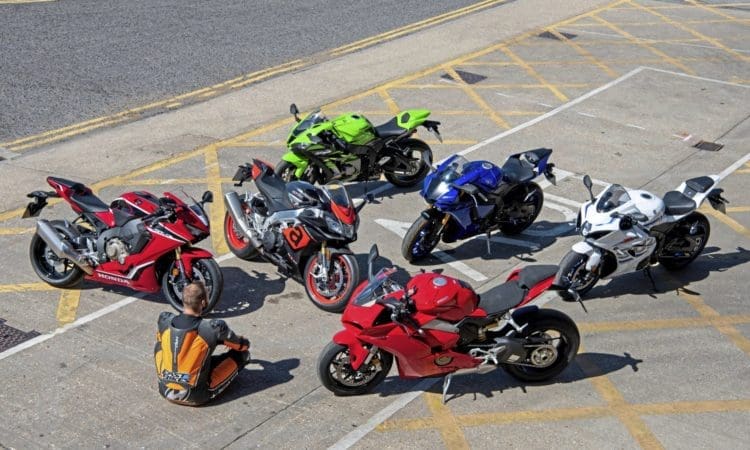Not everyone needs all the bells and whistles of top spec sportsbikes, so we lined up some base-model bullets to thrash it out on the road.
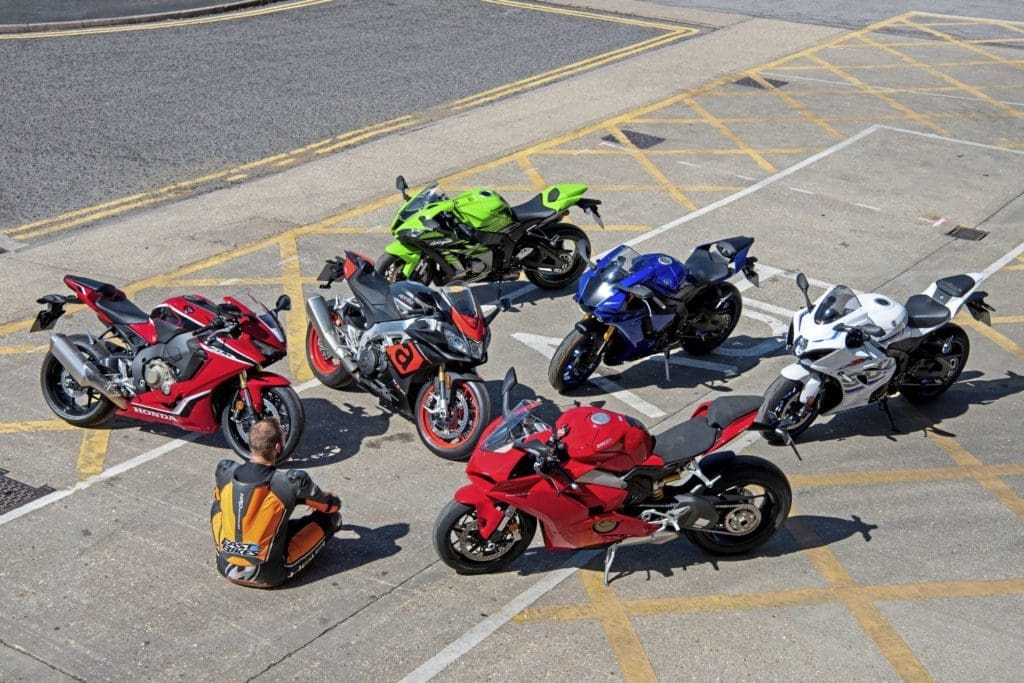
Some people wouldn’t be seen dead without their gold chain, sovereign rings and faux-Rolex watch, and it’s definitely true that all that stuff affords even the scummiest of bags a real air of sophistication. But some of us, no matter how hard we try, will never be sophisticated anyway so all the bling just wouldn’t be worth it.
And the same goes for litre sportsbikes. Yes carbon fibre bodywork, electronic suspension and umpteen levels of electronic engine self-castration not only helps in the riding department (for the most part anyway), they are a great talking point down the pub of the bikers café. But do we really need it? Is it worth the extra four or five grand? The base model litre bikes we have lined up range from £12,199 (for the Fireblade) to £19,259 (for the Panigale) and are, on average, £4,617 cheaper than the higher spec versions which we put to the test at this year’s Sportsbike of the Year (SBOTY).
Enjoy more Fast Bikes reading in the monthly magazine.
Click here to subscribe & save.
They come with (or should I say without) varying amounts of tech – notably, none of the six bikes on this test come with electronic suspension, whereas it SBOTY the Honda, the Kawasaki, the Yamaha and the Ducati all did. That doesn’t mean any of them are completely deficient in the technological department, oh no. All these bikes come with ABS, traction control, various power modes and none of them are, by any means, slow.
With the base models all being slightly less inclined to honing round a race circuit than their slightly more bling brothers and sisters we decided the best place for this test was on the road, so we planned a long loop with a mixture of different challenges which, in the interest of fairness, we tackled on all of the bikes…..
Bruce in Brief: Suzuki GSX-R1000

For me the Suzuki was a safe bet. It wasn’t exceptionally exciting, glitzy to look at or anything outstanding, but it did a great job of delivering a fast and fun ride. The motor’s it’s biggest talking point, feeling the most torque packed of all the in-line-fours on test. The sharp throttle connection takes a bit of getting used to, but once the motor’s spinning it never wants to stop.
It’s got a great gearbox too, but it’s a shame there’s no quickshifter or blipper to finish the package off. In the corners the Gixer’s no let down, being agile and planted. It’s an effortless ride and it’s pretty comfy too. You sit in the Suzuki, rather than on it, with decent leg room and a credible screen to write home about. The dash is a bit bland, but the ride more than makes up for it.
…..As per usual, I dragged Dangerous Bruce away from his Barbie dolls to aid me in my quest to find the very best base model superbike money can buy, and to find out whether it’s worth saving yourself a few quid next time you’re in the market for a new steed, by going for something with fewer frills. Is a bog-stock bargain the way to go, or you get what you pay for? Read on to find out.
Suzuki GSX-R1000
I think Marmite is absolutely gross but some people love it don’t they? I think the Gixer ‘thou, in its new white colour scheme, looks great though, despite plenty of people turning their noses up at it. Horses for courses, and all that. But it is a crying shame Suzuki couldn’t have done something a little prettier with the end can, which would look more at home slung under the wing of a Boeing 747. It’s like meeting a supermodel that’s got a club foot.
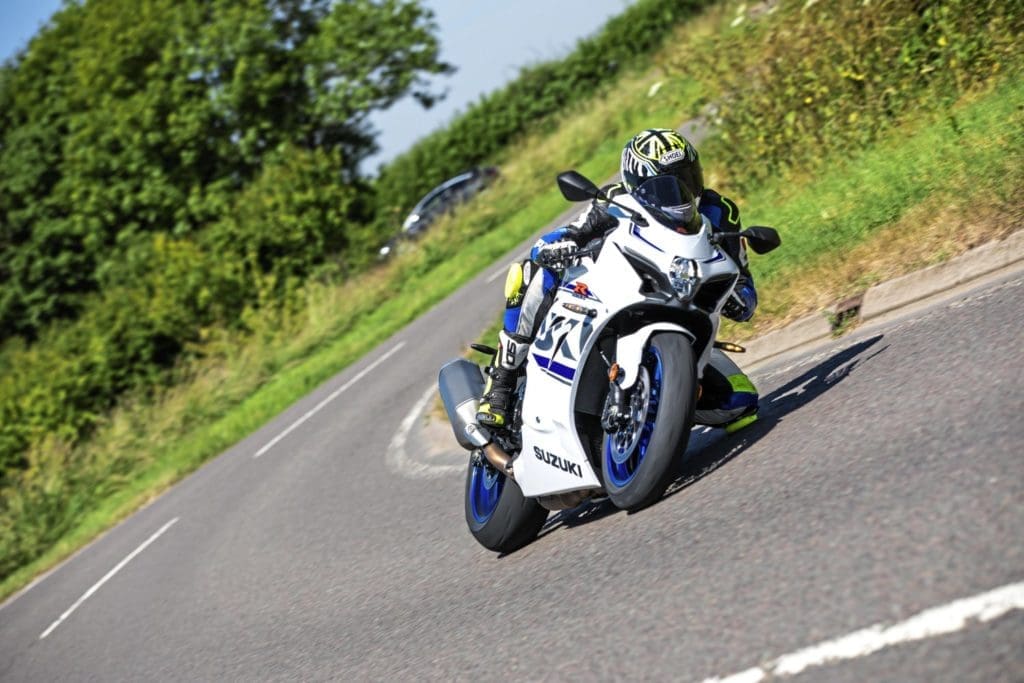
Anyway I was really looking forward to riding the Gixer, looks aside, I’ve always enjoyed riding big Suzukis. When I jumped on, it felt taller and narrower than I expected, probably a product of the high screen, but being 6 foot tall it wasn’t something that I was going to complain about.
You don’t have to do many miles on the Gixer to notice it’s not a premium quality motorbike. The dashboard that stares you in the face looks old and tired and just doesn’t seem to make a whole lot of sense, there is so much info on there that it’s difficult to tell what half of it is. Yes, you get ten levels of traction control, but you don’t get a quickshifter and you certainly don’t get a blipper. Ten level TC seems a little excessive and quickshifters are ten a penny these days so it seems a shame not to have one, perhaps Suzuki could swap say seven of them TC levels for a shifter.

The initial throttle pickup on the Gixer doesn’t feel premium either. There seemed to be a little play in the system somewhere, but once the engine started driving things were smooth and progressive. It wasn’t an aggressive feeling motor at all, it wasn’t one of them engines that’s snatchy and revs up really fast. Instead it had usable, friendly power that just kept going. It’s an engine that’s fast without feeling particularly fast. The best kind, in a lot of ways.
And the chassis compliments the motor perfectly. It feels so balanced all of the time, and no matter how hard you start to push the bike on the road, the thing just stays planted. Wheel-spins and wheelies were never greeted by nasty out-of-the-seat moments or horrible headshakes and its utter composure inspired so much confidence to do things with the bike that you maybe ought not to on the road. With a chassis that makes you want to throw the bike into corners and a motor that’s so smooth you can’t wait to open it up, riding the Gixer fast feels easy and it’s so much fun to do.

According to Suzuki the brakes have been updated for 2018 but on our test the ABS system still, on occasion, reared its ugly head. The brakes are ok on the Gixer but without the option to turn off the ABS you don’t feel as though you can really get the most out of them even on the road, never mind a track. Hard braking was invariably met with a pulsing lever that did its best to release the brakes, whether there was any real lockage or not. I’m not a fan of ABS on bikes at the best of times, but a system that feels as primitive as the Gixer’s doesn’t half let down what otherwise is a fantastic motorbike.
One thing I did experience on the Gixer was a slight numbing of the buttocks. Ergonomically, I didn’t feel as though it was a bad riding position at all, I was certainly comfortable to start with. But after about 80 miles my arse wasn’t very happy. Perhaps it is something to do with the seat, I don’t know, but none of the other bikes caused such a problem so quickly.

At £13,699 the standard GSX-R1000 is £2,600 cheaper than the slightly more trick GSX-R1000’R’ version. For your £2,600 you get a nicer dash, Showa suspension and a few other bits of bling but realistically the stock Gixer ‘thou will be plenty of motorbike for almost all road riders. I absolutely loved it.
Suzuki GSX-R1000 – £13,699
Kawasaki ZX-10R
Like the Gixer, the big Kawasaki doesn’t feel like a top-of-the-range, premium sportsbike.
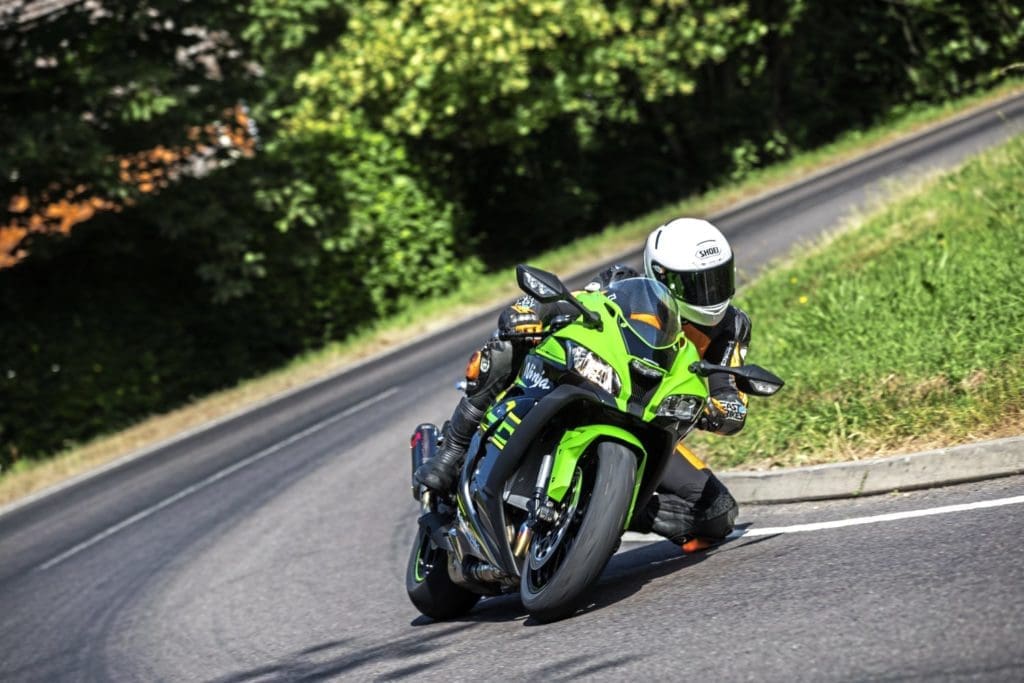
In fact next to some of the other bikes on test, it barely feels like a sportsbike at all. It’s like a big armchair that your body just seems to fit in, rather than be perched on top of, which isn’t always a bad thing.
The dashboard, which hasn’t been updated since 2011, is far from easy on the eye but is fairly tidy and all the info on there is clear. Rough as it may be, it’s the same dash that’s on the RR and SE versions of the ZX10, so it shouldn’t feel as though you’re settling for second best in that respect.
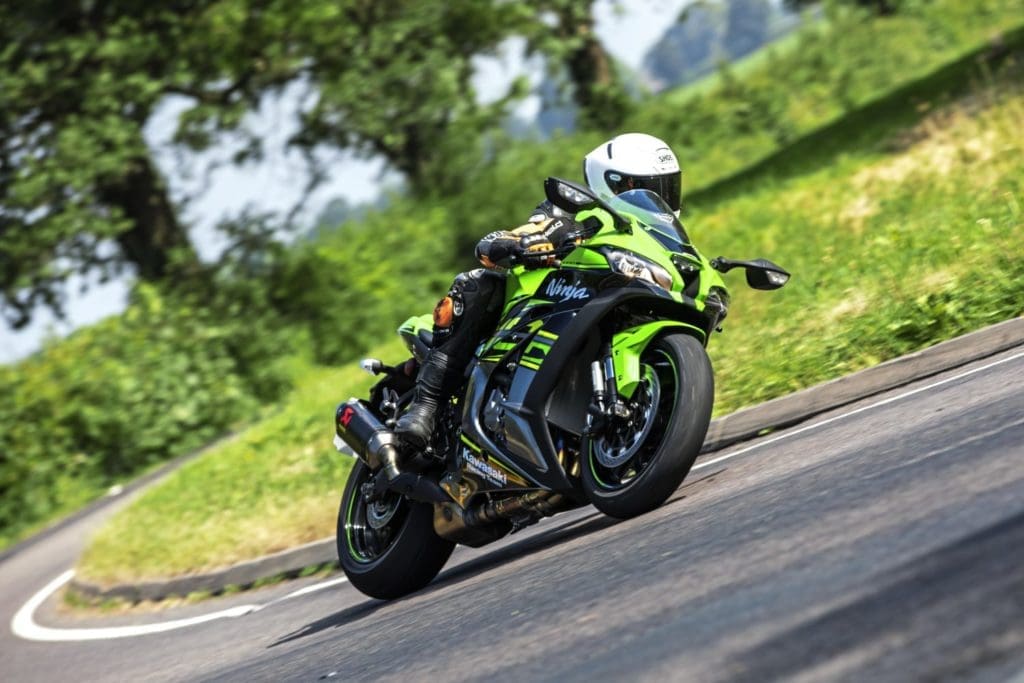
What does make sense on the Ten are its three power modes and three levels of traction control. Really, that’s all that’s needed on any bike, and it’s dead simple to toggle between the modes.
Something that makes a little less sense though, is the whoppingly-tall first gear. The ZX10’s motor has very little get up and go unless you are really revving the nuts off it and even in first gear nothing exciting happens until you’re doing about 60mph. Ok, so you can’t blame that entirely on the gearbox, the rev-happy power delivery ought to be held at least partially liable but whatever the reason, the ZX10 doesn’t really exude sportsbike qualities when ridden at anything like a sedate pace.
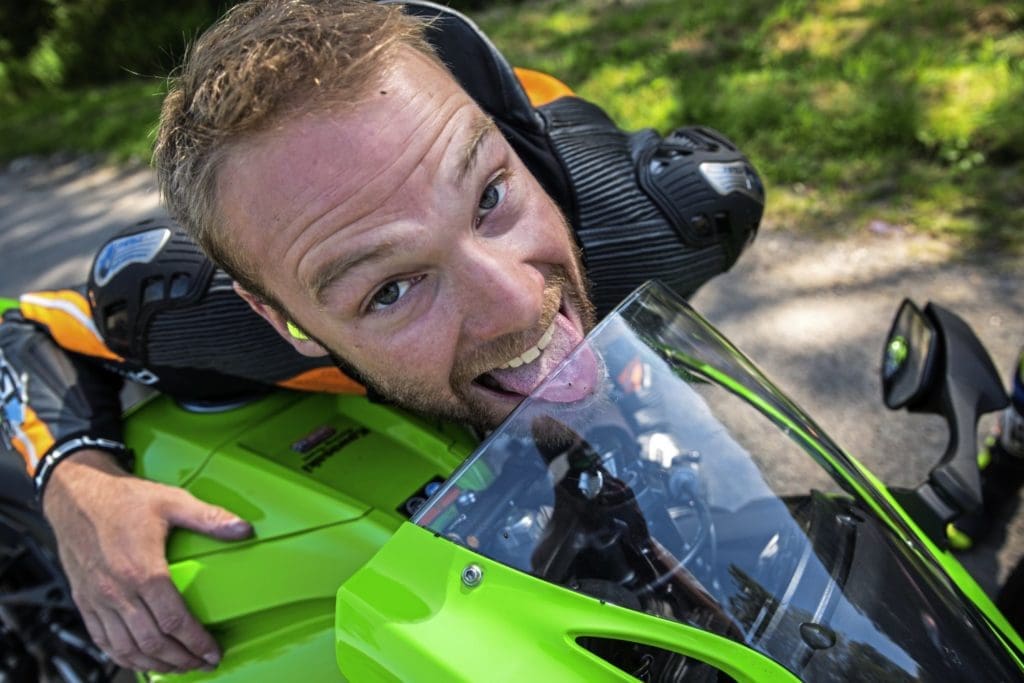
When you start trying though the revvy engine comes into its own. All the power is at the top of the rev range and to go fast you have really got to keep the thing singing its song. The bike we had on test had an Akrapovic end can on (cheating, I know) that sounded incredible and didn’t half make you want to rev the thing.
You never want to be too far away from the rev limiter, and when you get used to riding the bike in that way you really start to enjoy it. Some bikes are exiting and you fall in love with them straight away, but the ZX10 took a little bit of warming up to on our test – if feels less sporty and, arguably, less exciting than some of its rivals but what is exciting is the way you have to ride it to get the best from it.
It isn’t an easy bike to ride fast – you have to really work the gearbox and concentrate on keeping the throttle pinned, but isn’t that what riding sportsbikes is all about? After a few miles of riding like a lunatic I started falling in love – not with the ZX10, but with the way it was making me feel. I felt like I was wringing its neck and the green machine was screaming for more.
A helpful ally to wringing its neck is the Ten’s gearbox. The stock ZX10 doesn’t come with a blipper but you do get a quickshifter which works like a dream. The box and ‘shifter combo compliment hard riding nicely, it’s just a shame about how awkward first gear makes slower corners.

The Brembo brakes were adequate. Nowhere near as sharp as some but they always got the bike stopped on time and the ABS, although noticeable, wasn’t too intrusive or inconsistent.
Chassis wise, on the road the ZX10 does leave a little bit to be desired. Comfortable, though it is, it’s not the most nimble of things to get round corners, particularly the slower corners. It felt long and not terribly agile and when I did manage to get it on its ear, it didn’t tend to hold a line with any great deal of accuracy.
In the faster stuff things were much better. The Ten was more than happy to be fired through any of the faster turns we threw at it and never got too upset over any of the crests or bumps, despite the TC not always been sharp enough to catch the odd bit of wheel spin here and there.
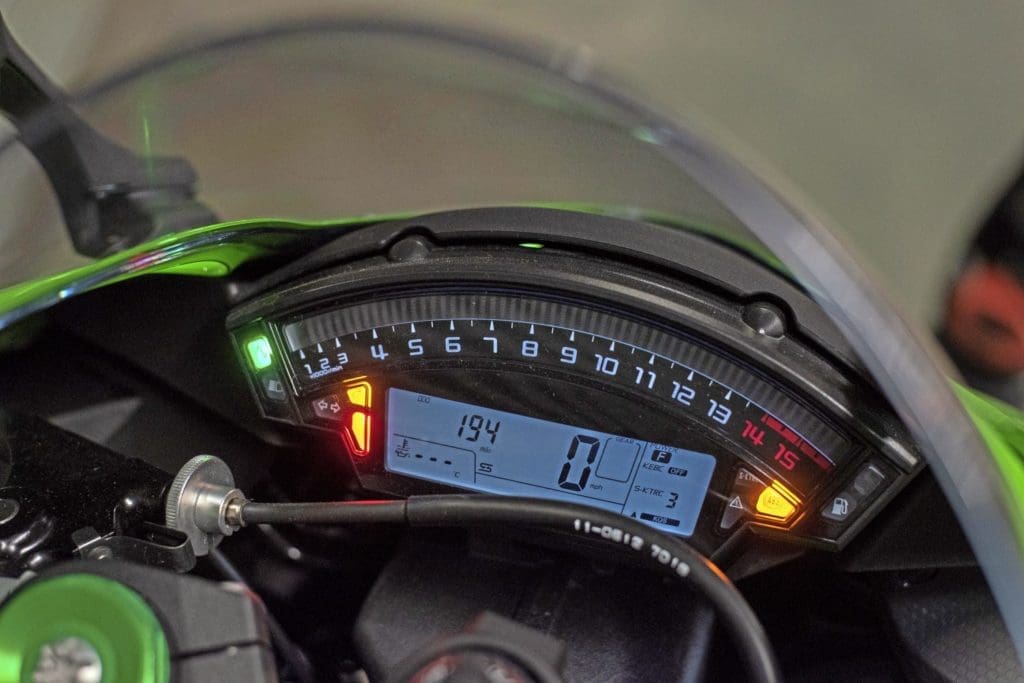
In Kawasaki corner, there are three ZX10-R models to choose from. The base model we tested comes in at £14,149, whilst the electronically suspended ‘SE’, which we tested in SBOTY, will cost you a whopping £18,949, but you do get a blipper and some Marchesini wheels thrown in for that. And for the racier contingent there is the ‘RR’ costing £16,249. For some, the Kawasaki won’t pack enough punch low down, but for me it packs more than enough at the top to make up for it. Ridden hard it’s bloody exciting.
Kawasaki ZX-10R – £14,149
Bruce in Brief: Kawasaki ZX-10R
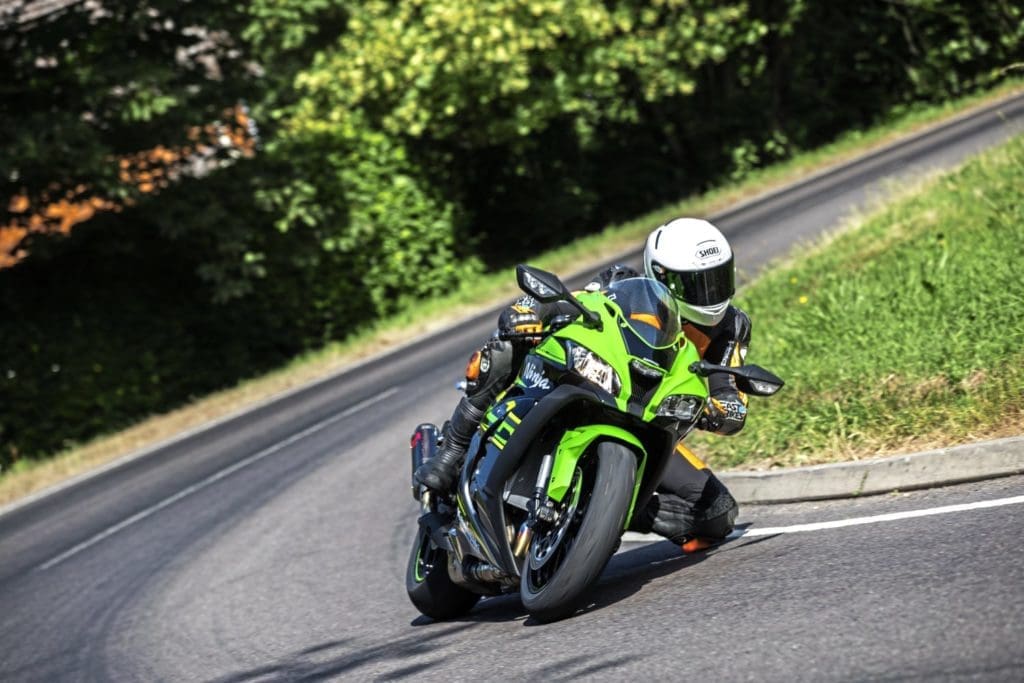
The main thing the Kwacker has in its corner is comfort. It’s a big old thing, with broad fairings, broad ‘bars and a seat that wasn’t built for size six glamour models. Engine wise, the power’s too rev happy to utilise effortlessly on the road, made worse by tall gearing. There’s not much tech to talk about either, with pretty primitive options of power modes and traction control on tap, but do you really need much more than those on the roads?
The system’s work well and the same goes for the bike’s front brakes. They’re pretty damn tasty under pressure, with no ABS hang-ups to note. Of all the bike’s on test the Kawasaki felt the most aged, mostly owing to its discothèque lovin’ dash, which really fails to hit the mark and flashes more than Boothy on a night out. It’s a nice bike to ride, but look elsewhere if you want pure excitement.
Yamaha YZF-R1
I’ve always been a massive fan of the R1, the current one, especially; I’ve always loved how racey they are.
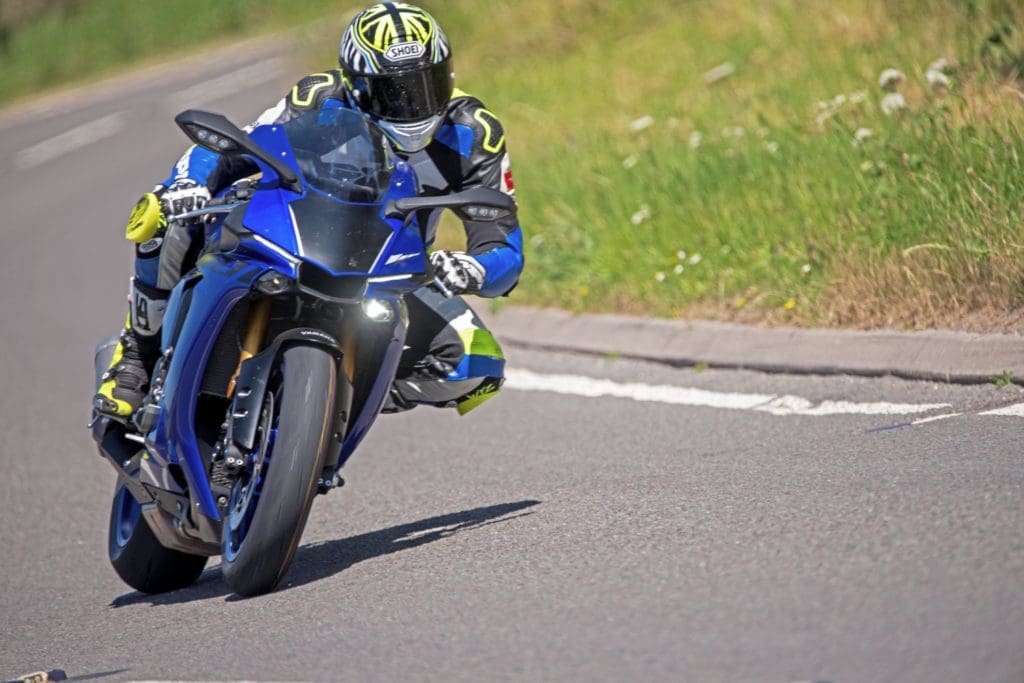
It’s got the looks of a super sporty, track orientated machine and that’s only hammered home when you throw a log over it. The seat feels high and the bars low so the bike naturally throws you into a bit of a racing crouch, but not to the extent that it’s uncomfortable.
The seat is still fairly arse friendly with loads of room to move around and the pegs aren’t so high that you need to stop every 10 miles to stretch your legs.
At really steady speeds and around town, I did find there was a lot of weight going through my wrists owing to the low, sporty bars, but as soon as you got up to about 50mph, the wind would lift your chest up and take the weight off your wrists. I did wonder if that was why Yamaha had given the R1 such a modestly sized windscreen.

Like the Kawasaki, the R1 has a fairly tall first gear but thanks to its extra grunt, is a bit more usable. I say extra grunt, there did seem to be a little lull in proceedings between about 3,000rpm and 8,000rpm. The throttle connection is beautiful and the initial pickup is there but it’s not until about 8,000rpm that things start to get bananas.
The power comes in all of a sudden, in such a surge that first and second gear surprise wheelies are not uncommon. And once you get used to it, first, second, third and fourth gear wheelies aren’t uncommon either. It’s an absolutely stonking motor that, provide you’re in its sweet, will let you hoist the front wheel with nothing but a crack of the throttle, no clutch necessary, no tugging of the bar necessary (no matter how much you like tugging your bar).
The standard R1 does come with a shifter and blipper, although I’d be reluctant to call it a ‘blipper’ as you don’t really get any audible blips on the downshifts, which is a shame. The up-shifter is fine and the down-shifter works adequately, but it doesn’t feel the sickest thing on the planet. You can feel a sort-of snap through the gear change on every downshift as things clunk into place and it doesn’t half feel like you’re taking liberties with the gearbox.
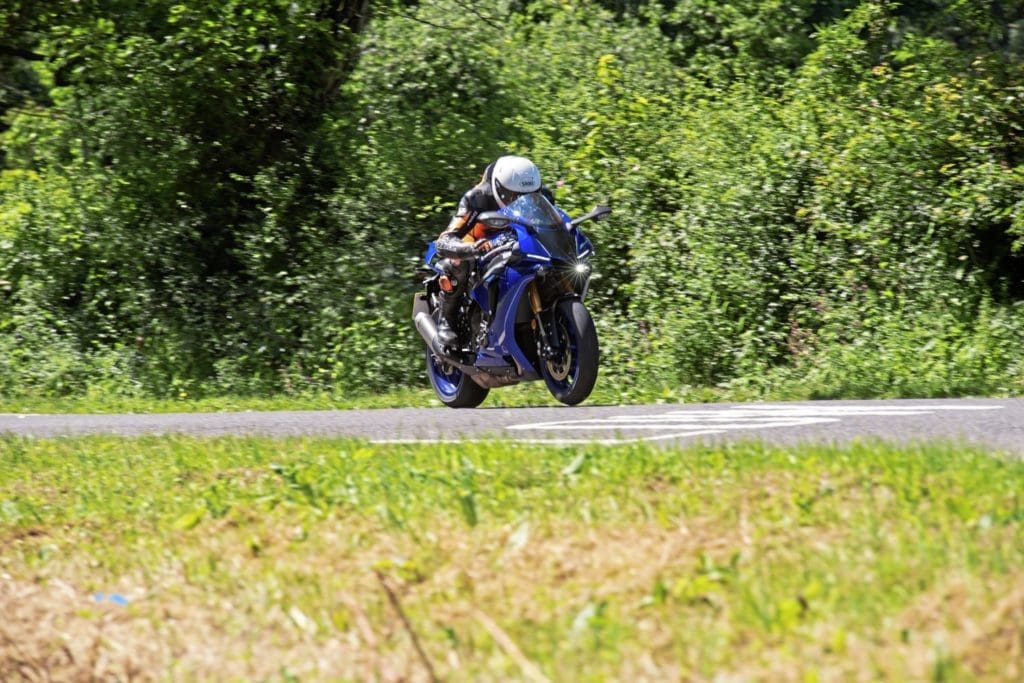
You can turn the up and down shifter off (although I can’t see why you would want to), what you can’t turn off, though, is the ABS. This is a problem on the R1. The brakes aren’t fantastically strong to start with, but couple that with an ABS system that’s way too intrusive and you’ve got yourself a recipe for disaster – there were a few occasions where I struggled to get the R1 hauled up in time and after riding the Panigale, for example, there was a certain amount of brain recalibration needed in braking department.
What did impress aboard the R1 was how well it handled. In the slow stuff it would drop into any turn like a goodun’ and always stayed absolutely planted, and in the fast stuff it just inspired so much confidence to attack the turns and get hard on the gas on the way out.
Ok, it made some shapes every now and then but that was thanks to the planted chassis giving you so much encouragement to open the taps right up whilst still on the side of the tyre. It was noted that when the R1 did start making shapes, it’s narrow, spindly race-bike-esque bars didn’t tend to offer the greatest levels of control, but let’s face it, how many of us are really in control when an R1 starts bucking and weaving underneath us, anyway!
The R1 is a race bike for the road, there is no two ways about it. It’s fast, edgey and exciting, but at £16,499 it’s not cheap. But you get what you pay for in this world – if you want to spend another £3,700 you can have an R1M, with electronic pogos, carbon fibre bodywork and a bit of extra tech, but if you don’t want to then you don’t need to because the standard R1 is an absolutely incredible bike on the road.
Yamaha YZF-R1 – £16,499
Bruce in Brief: Yamaha R1
This bike should come with a size warning, because if you’re over six foot or have anything like a beer gut on you, you’re going to struggle with the Yammy.

It’s tiny, but brilliant. It feels like a pedigree race machine, crafted with performance taking precedence over practicality, which is fine on track, but on the roads it’s maybe a little too focused.
The ‘bars feel sharply angled and they’re not much larger than chopsticks; the fuelling is harsh and rev hungry; the seat is firmer than a plank of wood. Comfort is not the R1’s forte, but its motor is insatiably potent, with a soundtrack that guarantees adoration.
The handling is sharp and precise and planted. It’s a real hoot to blitz around on and certain to please the consummate speedy road rider.
Honda Fireblade
The ‘new’ Blade had a bit of a hard time when it hit the market in 2017, struggling like buggery on race tracks and not really living up to its hype.
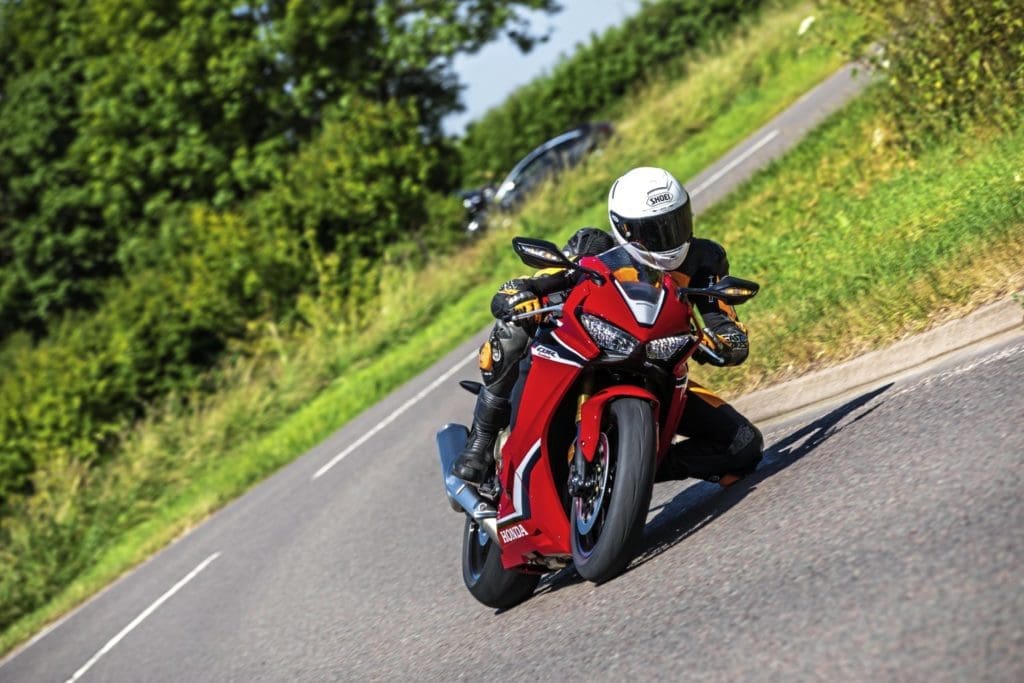
At SBOTY, the SP1 Blade couldn’t match the other litre bikes on speed or lap time, but we were optimistic about how the standard Blade would perform on the road.
Honda tell us that they have designed a bike for the road, which works on the tack, rather than the other way round. That doesn’t ring true when you sit on the Blade though; it has a fairly head-down, arse-up riding position that would definitely be more at home on a track than a road.
Like the R1, though, over about 50mph the wind lifts the weight off your wrists. Also like the R1, the frontal area of the Blade seems really quite sparse. The fairing is narrow and the screen is low which might be alright for the likes of Frodo, but for us man sized motorcyclists it doesn’t offer a whole lot of wind protection.
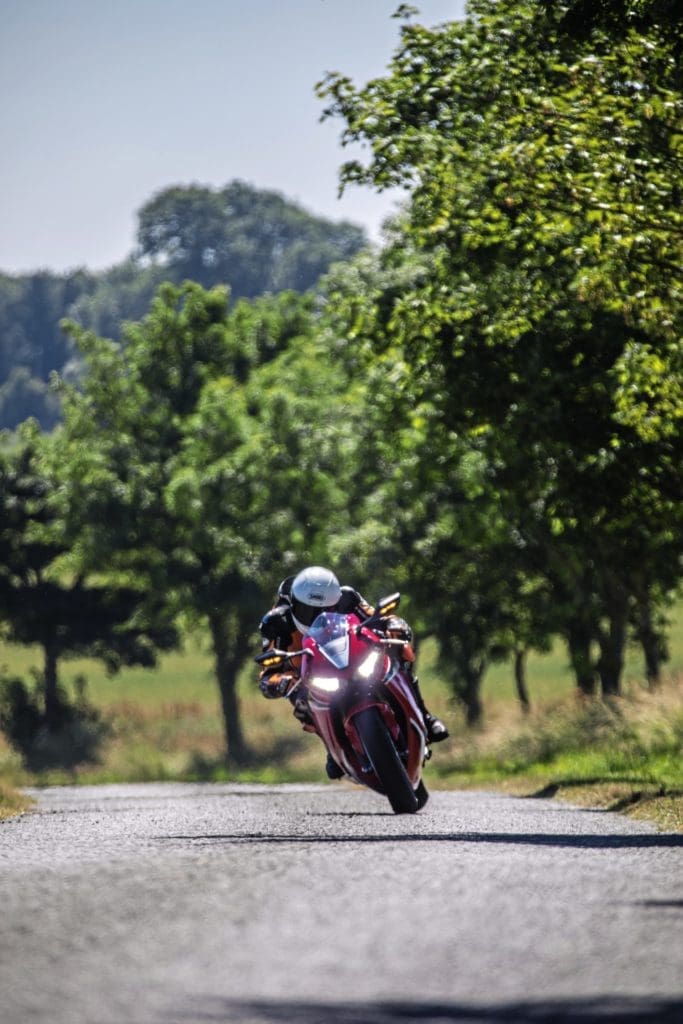
To make up for the lack of space in the cockpit, at least you’re treated to one of the nicest dashes on any of the standard bikes. It’s the dash that was designed for the £137,000 (£147,000 with the race kit) RCV213V-S, Honda’s MotoGP V4 for the road – well they weren’t going to put any old tat on that were they? It looks pretty and everything is pretty clear on there. I did struggle to work out how to adjust the traction control (or torque control, as Honda have called it) and power modes but once id figured it, it wasn’t too bad.

To turn TC off you need to be in ‘user mode’. There is even three level adjustment of the engine braking map, but I couldn’t really tell much of a difference when I faffed around with that. Like most of the other bikes on test, skids and stoppies were strictly forbidden by the un-turn-off-able ABS.
But that’s where the fancy electronics stop. Like the Gixer, the blade doesn’t come with a shifter or blipper so the ride does lack premium feel that the sexy dash might suggest. And the motor isn’t as sharp as the other bikes on test. It’s not horrible, in fact it’s far from horrible. It’s actually really nice motor, it’s friendly and easy to use.
There is a slight flat spot between 5,000rpm to 7,000rmp, but other than that it’s a very smooth engine. Possibly too smooth. Compared to the other bikes on test it did feel a little slow and a little bit less exciting. That’s not to say that it is slow. When you’re giving it some it’s still capable of landing you in prison, should the constabulary spot you. In actual fact they are more likely to hear you than see you, as the stock can on the Blade emanates a deep, throaty (did someone day deep-throat?) roar that that few other OE cans could hold a candle to.

Fast road riding, it would seem, is what the Blade has been designed for. The engine might not sting like a bee, but it doesn’t half float like a butterfly. The blade rail-roads through fast turns and changes direction effortlessly, at whatever speed; it’s a typical Fireblade.
On SBOTY the electronics in the suspension on the SP1 Blade were praised for soaking up the bumps round Navarra so proficiently, but the Showa suspension on the stock Blade chewed up and spat out any of the bumps we threw at it on our test, rarely transferring any naughtiness through the chassis.

It’d difficult to fault the Fireblade. It probably is the perfect road bike, it’s fast (enough), looks great, easy to get on with and does everything you ask it to. It’s a fantastic bike and, being the cheapest bike on test, it does justify its price tag. But for some, it might be lacking a certain edge. The X-Factor, so to speak.
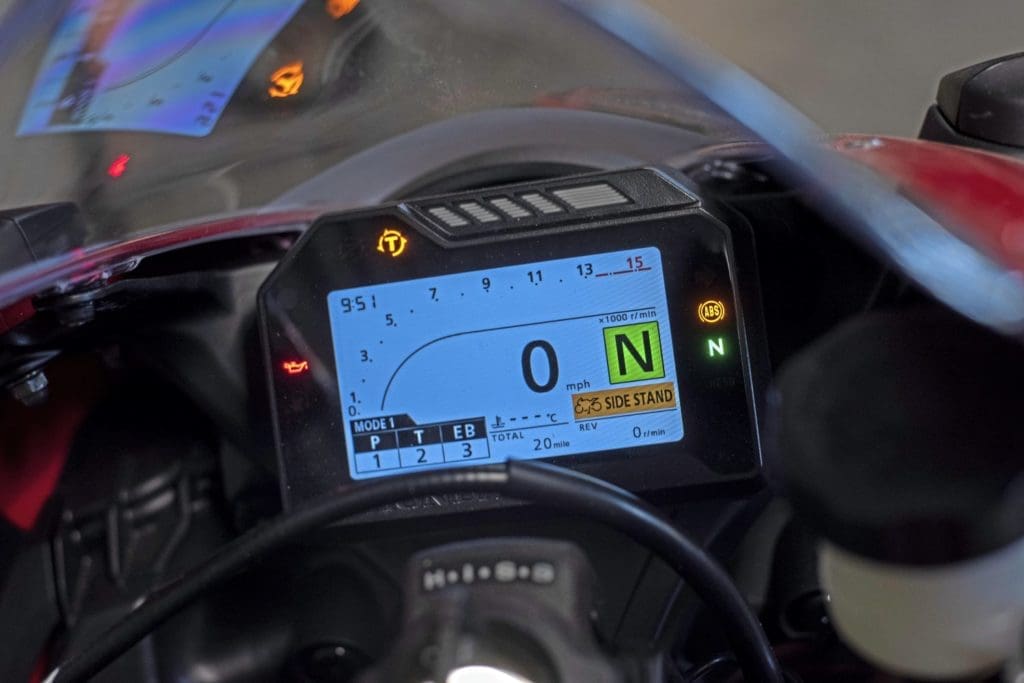
Honda Fireblade – £12,199
Bruce in Brief: Honda CBR1000 Fireblade
It gets something of a kicking on track, but the Honda comes into its own on the road. It motor’s strong from low down and, despite a little flat spot around 6,000rpm, delivers a powerful experience all the way to its limiter.
I don’t know why you need any more ponies on the road, short of having a small manhood. What it could also do with being a bit bigger is the screen, as it’s tiny and appears more of a gesture than anything. The riding position’s a little cramped too; arse up, head down-stylee, which does your wrists in after a while. The tech’s ok, though like the Gixer it lacks a shifter and blipper.
The colour dash is a very nice touch and adds to the Blade’s attractive image. It’s a great handler, being very agile and feeling really planted in a corner. Another good thing to note is that the ABS dramas don’t show their head during typical road riding.
Ducati Panigale v4
The Ducati, being a Ducati, is the dearest bike we had on test.
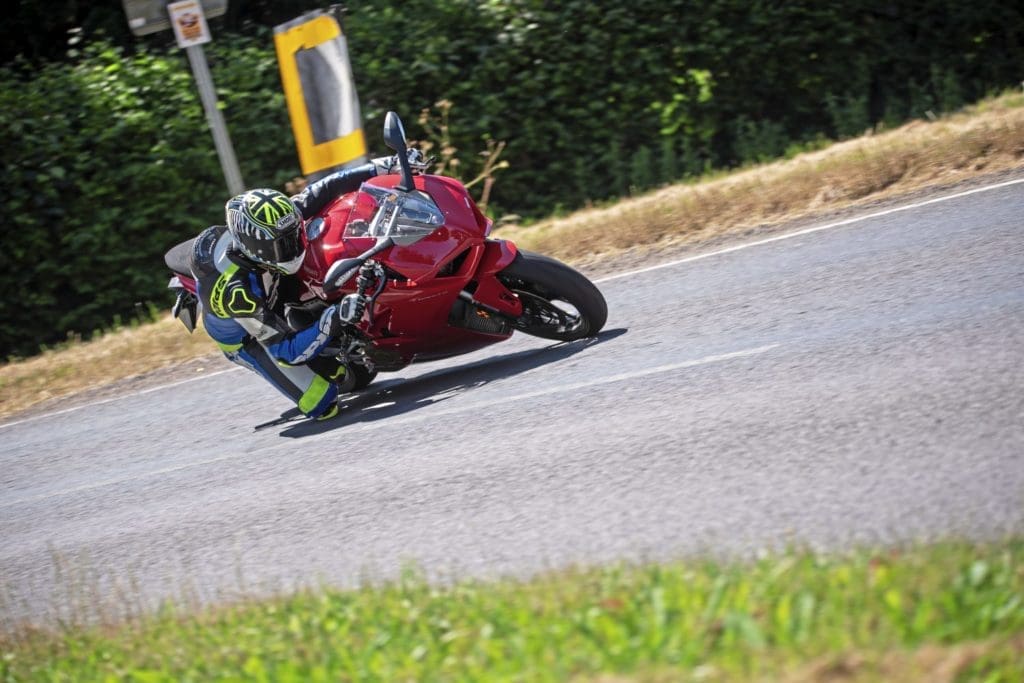
But even this, the base model V4, felt like a special bike. From is shiny red bodywork to its suede-like seat, the Duke oozed class. Its sharp angles and lines give it the look of an out and out track focused machine, but when you throw a leg over you realise that, small though the V4 is, there is actually ample room for a decent sized pilot. The bars are far enough forward and the pegs low enough to be comfortable; it’s as though someone has chucked some bodywork on naked street bike.
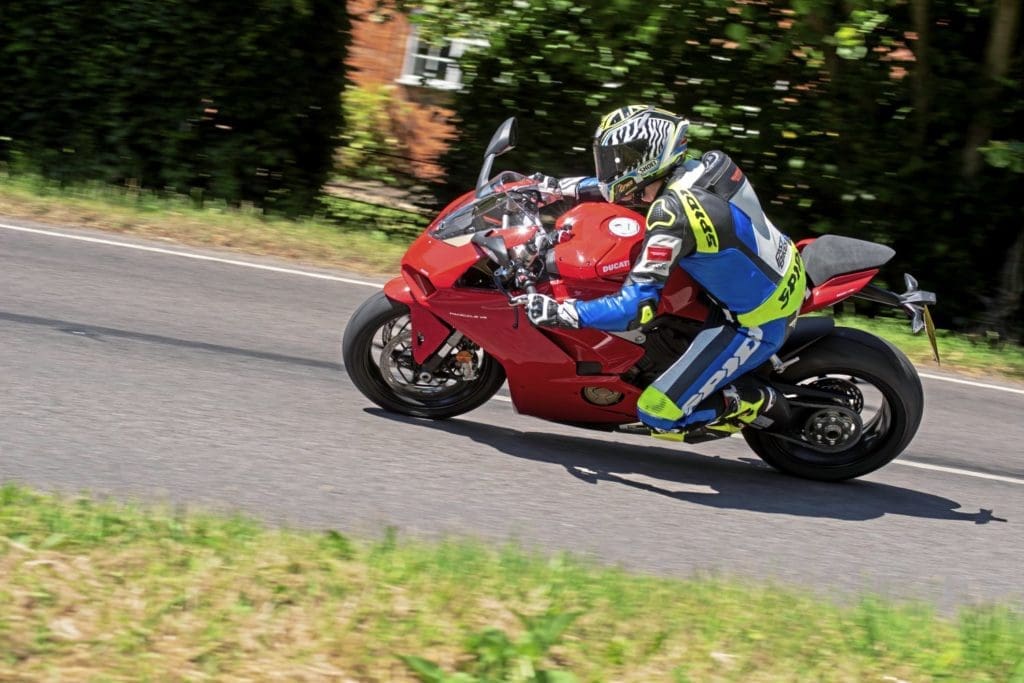
That is until you fire the motor up and take for a spin. From the get-go the motor feels strong, possibly a little too strong at first; negotiating a busy carpark wasn’t the easiest of tasks on the V4 as the initial opening of the throttle, at very low revs, felt a bit harsh and jerky. Junctions were a bit of a pain too, the Duke liked plenty of revs when setting off; Bruce and I both had an embarrassing stall or two.
Once the engine is opened up the drive the Ducati dishes out is super impressive – it’s not lumpy like Ducatis of old. It pulls so hard wat ever gear you’re in and just begs for the next gear, and the next gear, and it doesn’t take long to lose track of how fast you’re motoring along. Luckily, these incessant gear changes are helped along the way with a quickshifter, which works like a dream, and treats you to a little pop every now and then, if you get the revs just right. Downshifts are aided by a decent blipper too, putting it up there with the R1 and RSV4 for gadgetry.
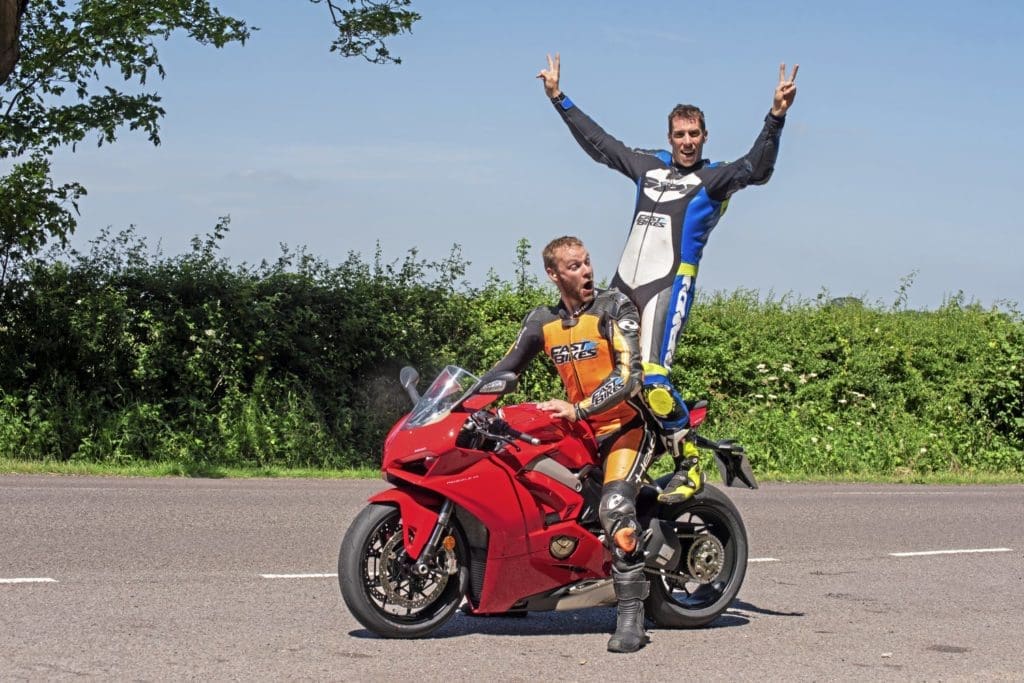
Whilst we are on the subject of gadgetry, the V4 does come with some pretty cool systems which are really easy to faf with via the left hand switch gear and the nice big dash. Traction control, slide control and wheelie control can all be altered. The slide control was great and did a good job of reigning the Pirellis in on more than a few occasions, what I wasn’t a fan of though was the wheelie control.
If you had 100% faith in the system and kept the throttle absolutely pinned it was usually ok, but as soon as you dipped the throttle, even only slightly, to try and control a wheelie yourself, the system would have a fit and send the front wheel crashing unceremoniously to the ground.
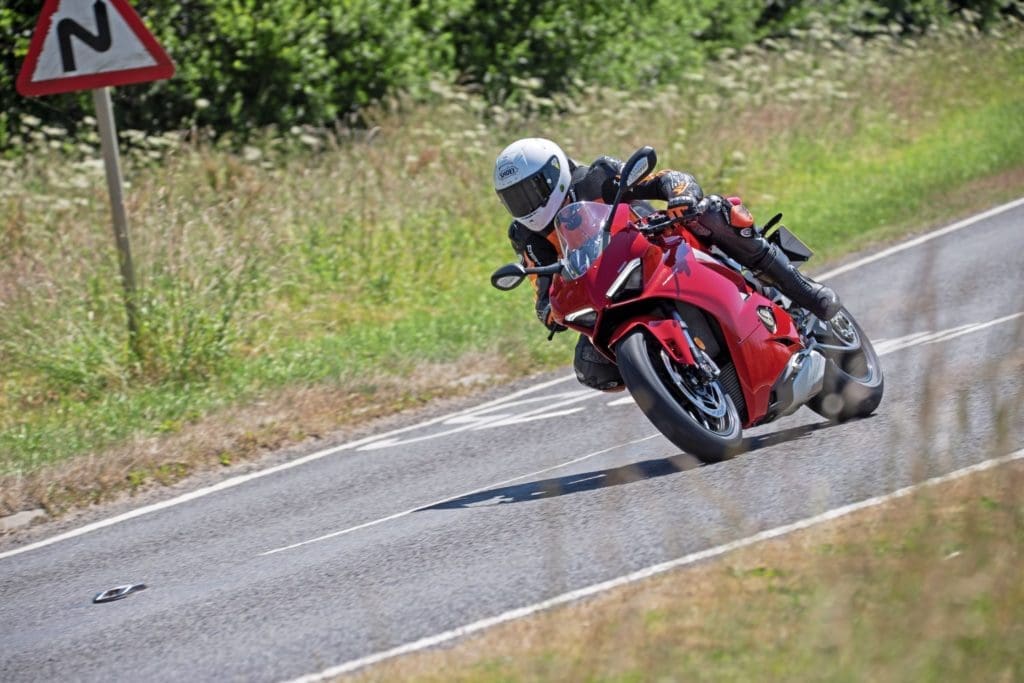
If wheelies aren’t your thing, and you prefer the doing stoppies, you will love the Duke. The brakes are absolutely phenomenal, even with ABS. the Ducati goes to prove that you can make an ABS for bike that doesn’t completely ruin the brakes. The Brembo brakes were sharp, strong and only interfered with then absolutely necessary; there were fantastic. The clutch and brake lever also had span adjusters on which I thought was a nice touch.
A contributing factor as to why the V4 Panigale only finished fourth at SBOTY was its scary speed weave. Some blamed our swapping the OE fitment Pirellis to Bridgestone R11s but it wasn’t long before that accusation was relegated to the bollocks bin. When pushed, the Ducati displayed the same waviness on the Pirellis on the road, as it had done on the Bridgestones on the track.
But it’s worth bearing in mind, though, that this only ever happened when the Duke was really having its cables stretched and getting pulled left, right and centre. And in actual fact, although on the track, it was to the detriment of lap times, on the road it just made riding the V4 bloody exciting. You could tell how hard you were pushing the bike by the shapes it was making, it was a laugh a second.
In the slow to medium speed stuff there wasn’t many other bikes that could keep with the Duke. It would drop into corners like a sorted Supersport bike and could hold a line just as well, giving you the confidence to use its motor to (something like) its full potential on the exit of every bend.
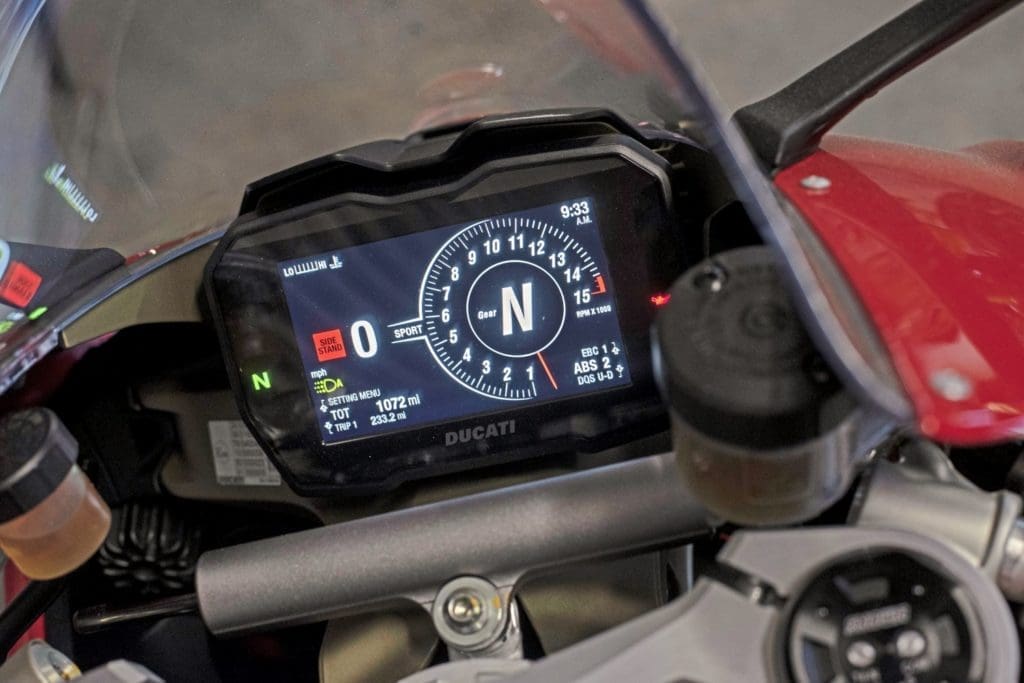
If you’re buying a Ducati to make a statement then you’re probably not going to go for the base model, poor-man’s Panigale. But if you want a bike that blows every Ducati away that’s been before it, and you want some change from £20k, then the stock V4 might just be the bike for you.
Ducati Panigale V4 – £19,259
Bruce in Brief: Ducati V4
How you can own one of these and keep your licence is beyond me.
This thing is fast, furious and so much fun. It’s a lively bike, with a playful nature and it’s also deceivingly quick. Just because you’re not buzzing the tits off its tantalisingly brilliant V4 motor doesn’t mean that you’re not breaking the speed limit four times over.
Everything’s a blur, because you get so wrapped up in the sensation of the big Ducati, which grabs you by the balls and eggs you on willingly. I can’t believe how much tech it’s got, which is all easy to alter and performs a treat on the road. The brakes are exceptional and I really liked how spacious it was.
The ‘bars are broad enough for bodybuilders and the seat is genuinely comfy. It handles a treat and though it can weave a little at speed, it feels a very predictable and endearing bike to ride. I just wish the sidestand wasn’t such a fight to put down.
Aprilia RSV4 RR
When the RSV4 RR arrived at FB HQ, Dangerous and I were both dead keen to throw a leg over it.
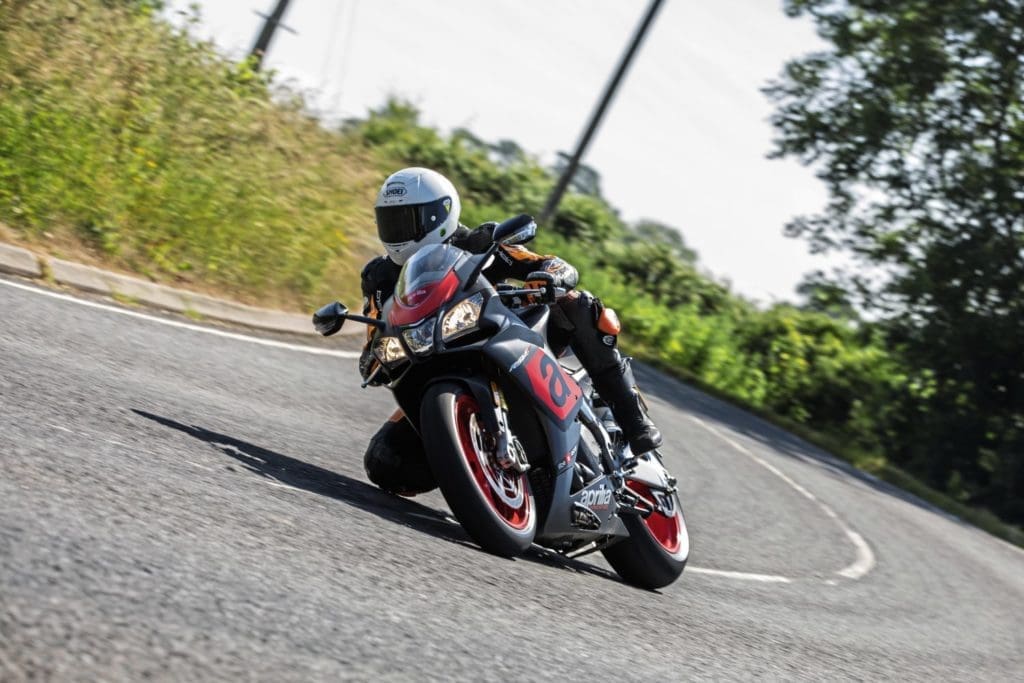
We’d both fallen in love with the tricked up RF version at SBOTY, which had blitzed the opposition so convincingly in Spain, so neither of us could wait to see how the stock version would cope on the road.
The RR’s spacious cockpit and small dash were quite familiar as was the boom of the big V4 engine when fired up. Despite having the same configuration as the Ducati, the Aprilia’s engine seemed more sharp and snappy; it would bark loudly with each blip of the throttle, and every time I did it my willy would tingle, just a little bit.
Out on the road, the motor sounds just as good, but it doesn’t have the same unrelenting drive as the Duke. It’s fast, but quite not as fast. The Aprilia does seem to suffer from a slightly premature rev limiter too, there would definitely be more power, given an extra 500 revs or so. But what it lacks in top end, it makes up with its huge spread of power. There is strong power wherever the (imaginary) needle is, so you don’t need to worry too much about working the gearbox to keep the thing revving.
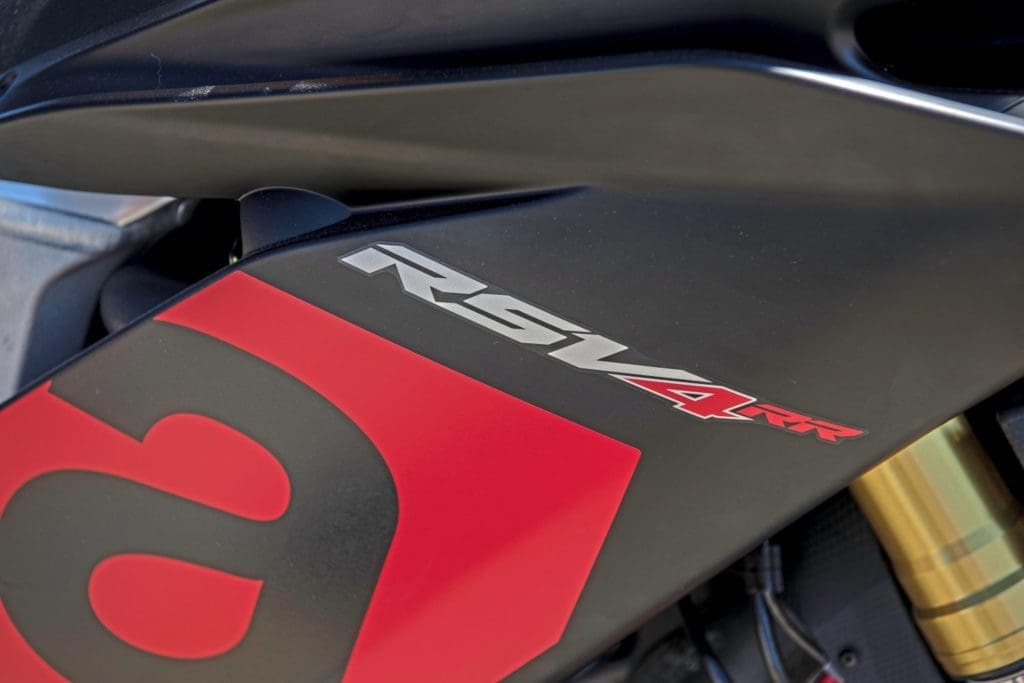
If you do want to work the gearbox, though, the shifter and blipper will happily oblige you. Apart from the masses of slogger on the shift lever, both up and down shift functions work perfectly. My personal favourite thing about the down shifter is the fact that it works whether the throttle is closed or wide open (most other systems only work on a fully closed throttle), so you can be on the stopper trundling along in sixth gear and bash it down two or three gears without rolling off, to buzz past your mates, or a line of cars following a tractor.
Sure, speeding up is good fun on the Aprilia, but slowing down is just as good. ABS on setting one is barely noticeable and the brakes are more than sharp enough for road riding. Its proof, once more, that ABS doesn’t have to completely ruin your brakes.
As well as the ABS, the power modes and traction are all programmable, using the left hand switch gear, once you work out how to do it that is. The switch gear feels a bit cheap and the indicator buttons a little rubbery. The left bar is covered with buttons, joysticks and all sorts, whereas the right hand bar has a simple on and off switch. It did seem really rather peculiar.
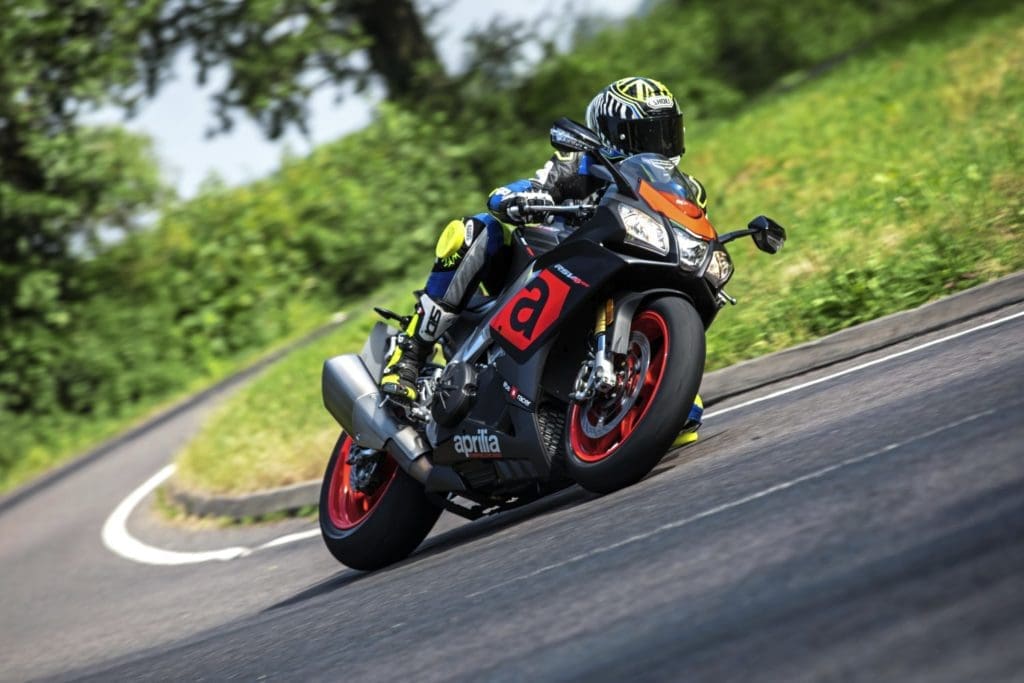
Once I got the hang of scrolling though the menus, I decided to turn the wheelie and traction control off to have a little fun. And fun I did have. With engine castration level set to zero, the V4 lump really shone. It seemed to fuel so much cleaner and not lull or miss when it detected anything untoward. It still wasn’t as fast at the Ducati though.
It was a match for the Ducati in the bends though. It was as agile as anything round our test loop and was never a struggle to pull from one knee-down lean angle to the other. Once or twice, in some of the faster, bumpier bends there was a little bit of bouncy chatter, but never anything to get upset about and never anything that made you need to roll the throttle. When we were giving it the berries, and climbing around the bike to get it to turn, I found the rear of the fuel tank really uncomfortable on the insides of my thigh. It has a sharp(ish) edge that that digs in when your hanging off the bike that I wasn’t a fan of.

The RSV4 RR is an awesome bike on the road. At £15,599 it’s cheaper than the Yam and the Duke, but it’s still a hefty price tag. If you need an RSV4 in your life (and I couldn’t blame you if you do), you could pay another £4,400 and opt for the RF, which comes with Öhlins suspension and forged wheels. But on our test, the standard RSV4 was every bit the bike we needed it to be.

Aprilia RSV4 RR – £15,599
Bruce in Brief: Aprilia RSV4 RR
The Aprilia’s a favourite on track and it doesn’t disappoint on the road either. The motor’s a little lacking at very low revs, but then it comes into its own and kicks out the creamiest, torquiest and straightest power delivery this side of a race bike. Couple that with the V4 sound track and you’re pretty much in heaven. It’s a great handler too. It’s not the most agile, but it always feels planted and accurate. Even though it’s not got fancy Öhlins like the RF, the RR’s pogos don’t leave you disappointed.
It’s a small bike though, so be prepared to feel a little cramped. The brakes are good and the tech on tap is pretty exceptional and child’s play to operate. The traction control paddles are a nice touch, and so is the TFT colour dash. It looks as good as it goes.
Conclusion
I understand that having a supermodel on your arm really does wonders for your street cred, just like turning up to a bike night on an all singing, all dancing, top of the range superbike.
But what has the supermodel got that the girl next door doesn’t? Plastic tits, an inch of makeup and an insatiable appetite for co…. nversation? Well maybe, but how much do such superficial qualities really improve your life? Take the R1M for example with its sexy carbon fibre bodywork – does it turn the R1 a featherweight racer? No, in fact it’s actually 1kg heavier than the standard version (thanks to the weighty electronics systems).
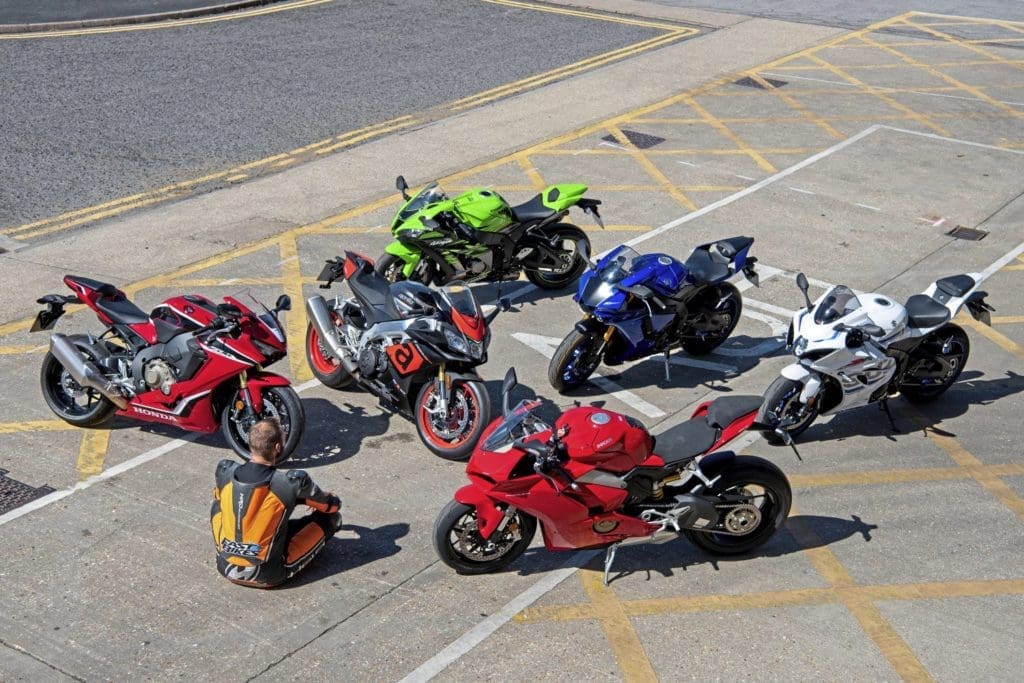
And you might argue that the lack of a quickshifter on the Blade and the Gixer might sway some to go for the top spec models, but there are plenty of aftermarket parts out there for a two or three hundred notes, if you did want to go down that route. And as for electronic suspension, which the Blade, the R1, the ZX10 and the Duke all come with in their higher spec versions, well on our test, we never missed it. Sure, leccy pogos do tend to do a nice job of ironing out bumps and ripples in the road but let’s be fair, sportsbikes aren’t made for bumpy roads. If you’re riding on shitty roads, buy a sports tourer.
The six bikes we put through their paces were all impressive in their own way. The Gixer, despite feeling a little cheap, made riding fast so easy and never made you feel like you were asking too much of it. The Kwacka, although feeling lazy at first soon came into its own and before we knew it we were bouncing it off the limiter at every opportunity (partly because you had to) and loving life. The R1 was a completely different kettle of fish, tight, crampt and sporty feeling, the consummate racebike for the road. In a lot of ways like the Ducati, which was fast, sporty and packed with tech, though it proved a lot more comfortable and spacious compared to the R1. Less spacious was the Blade, which provided very little room for a pot-bellied 6 footer like me to tuck in out the wind, but in all fairness, although it was fast, it felt the least ‘racey’ of the gang. And then there was the Aprilia, who is sure to make you fall in love with its V4 boom, its plush handling and its awesome brakes.
Unlike at SBOTY, where the Aprilia’s brilliance was undeniable, on our road test there was no stand out winner. The Ducati, Aprilia and Yamaha might have to power to knock your socks off (and the tech to match) but you don’t half have to pay for it. Whereas the Honda, Suzuki and the Kawasaki might not be able to offer the same power figures (or tech), but are all under the £15,000 mark. We all want something slightly different from our road bikes, some want a bike more space and comfort, some want the extra tech, and others just want out and out power. Whoever you are, whatever you want, there is a litre sportsbike to suit you.
 Enjoy more Fast Bikes reading in the monthly magazine. Click here to subscribe.
Enjoy more Fast Bikes reading in the monthly magazine. Click here to subscribe.

